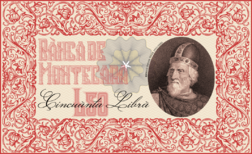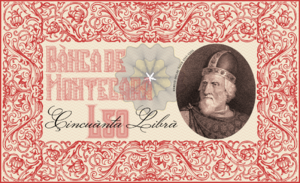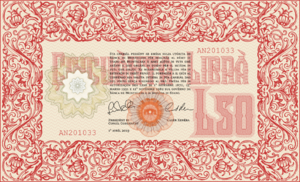Montecaran libra: Difference between revisions
No edit summary |
No edit summary |
||
| (17 intermediate revisions by the same user not shown) | |||
| Line 6: | Line 6: | ||
| using_countries = {{flag|Montecara}} | | using_countries = {{flag|Montecara}} | ||
| unofficial_users = | | unofficial_users = | ||
| inflation_rate = | | inflation_rate = 1.80% | ||
| inflation_source_date = | | inflation_source_date = [[College of State (Montecara)|Secretariat of Finance]] (Q4 2019) | ||
| inflation_method = | | inflation_method = | ||
| subunit_ratio_1 = 1/12<br>1/100 | | subunit_ratio_1 = 1/12<br>1/100 | ||
| Line 17: | Line 17: | ||
|frequently_used_coins = Ł1, Ł2, Ł5, Ł10 | |frequently_used_coins = Ł1, Ł2, Ł5, Ł10 | ||
|rarely_used_coins = | |rarely_used_coins = | ||
|frequently_used_banknotes = Ł20, Ł50, Ł100, Ł200 | |frequently_used_banknotes = Ł20, Ł50, Ł100, Ł200, Ł500 | ||
|rarely_used_banknotes = | |rarely_used_banknotes = Ł1,000 | ||
| issuing_authority = [[Bànca de Montecara]] | | issuing_authority = [[Bànca de Montecara]] | ||
| issuing_authority_website = [http://banca.go.mc banca.go.mc] | | issuing_authority_website = [http://banca.go.mc banca.go.mc] | ||
| Line 24: | Line 24: | ||
| printer_website = | | printer_website = | ||
| mint = | | mint = | ||
| pegged_with = | | pegged_with = | ||
| value = | | value = [https://docs.google.com/spreadsheets/d/1uhnbgoGSEyVMRrApge1Lscs1ZgUjc8ztmuDTV4yHrcc/edit#gid=338417074 Link: real-time value] | ||
}} | }} | ||
The '''Montecaran libra''' is the official currency of [[Montecara]] | The '''Montecaran libra''' is the official currency of [[Montecara]]. It is issued by the [[Bànca de Montecara]]. It has a {{wp|Floating exchange rate|floating exchange rate}} and is one of the ten most-traded currencies in the world. | ||
== History == | == History == | ||
The libra is ultimately derived from the {{wp|troy pound}} of silver that formed the basis of the monetary system in the [[ | The libra is ultimately derived from the {{wp|troy pound}} of silver that formed the basis of the monetary system in the [[Solarian Republic]]; “libra” is the Solarian word for “pound.” From classical times to 1870, the libra was on the {{wp|silver standard}}; between then and 1951, it was on a {{wp|bimetallism|bimetallic}} gold and silver standard, where the price of gold was periodically readjusted to the price of silver. The convertibility of the libra to gold ended in 1982, when the [[Bànca de Montecara]] decided to make the libra a {{wp|Fiat currency|fiat currency}} and let its value float on the international market. | ||
Until 1982, the libra was subdivided into 12 ''onçià'' | Until 1982, the libra was subdivided into 12 ''onçià'' and each ''ònçia'' was in turn divided into 30 ''scrupi''. Thus, the libra was equal to 360 ''scrupi''. That system was abandoned in favor of a decimal system (for electronic transactions) and ¼ and ½ libra coins for cash transactions. | ||
Having a floating exchange rate allows Montecara to maintain a sovereign {{wp|monetary policy}} without imposing {{wp|capital controls}}. | |||
== Coins == | == Coins == | ||
{|class="wikitable | {|class="wikitable" | ||
|- | |- | ||
!rowspan="2"|Image ||rowspan="2"| | !rowspan="2"|Image | ||
!rowspan="2"|Value | |||
!rowspan="2" |Diameter<br>(mm) | |||
!rowspan="2" |Thickness<br>(mm) | |||
!rowspan="2" |Mass<br>(g) | |||
!rowspan="2" |Composition | |||
!rowspan="2" |Edge | |||
!colspan="2"|Description | |||
|- | |- | ||
!Obverse||Reverse | !Obverse||Reverse | ||
|- | |- | ||
|align="center"|[[File:Libra1.png|100px]]|| | |align="center"|[[File:Libra1.png|100px]] | ||
|Ł1 | |||
|20 | |||
|1.60 | |||
|4.31 | |||
|{{wp|Nickel silver}} | |||
|Smooth | |||
|Denomination, bank mark, and year ||Heraldic arms of {{wp|Saint Stephen}} | |||
|- | |- | ||
|align="center"|[[File:Libra2.png|120px]] || | |align="center"|[[File:Libra2.png|120px]] | ||
|Ł2 | |||
|22.4 | |||
|1.80 | |||
|6.08 | |||
|Nickel silver | |||
|Smooth | |||
|Denomination, bank mark, and year ||Wreath of coral and trident | |||
|- | |- | ||
|align="center"|[[File:Libra5.png|150px]] || | |align="center"|[[File:Libra5.png|150px]] | ||
|Ł5 | |||
|25 | |||
|2.00 | |||
|8.41 | |||
|Nickel silver | |||
|Smooth | |||
|Denomination, bank mark, and year ||Scallop shell and waves | |||
|- | |- | ||
|align="center"|[[File:Libra10.png|200px]] || | |align="center"|[[File:Libra10.png|200px]] | ||
|Ł10 | |||
|28 | |||
|2.24 | |||
|9.67 | |||
|{{wp|Nordic Gold|Nordic gold}} | |||
|Smooth | |||
|Denomination, bank mark, and year ||[[Flag and coat of arms of Montecara|Coat of arms of Montecara]] | |||
|} | |} | ||
| Line 66: | Line 93: | ||
!colspan="2"|Image | !colspan="2"|Image | ||
!Value | !Value | ||
!Dimensions<br | !Dimensions<br>(mm) | ||
|- | |- | ||
|align="center"| | |align="center"| | ||
|align="center"| | |align="center"| | ||
|Ł20 | |Ł20 | ||
| | |148 × 70 | ||
|- | |- | ||
|align="center"|[[File:MC-L50obv.png|300px]] | |align="center"|[[File:MC-L50obv.png|300px]] | ||
| Line 92: | Line 119: | ||
|Ł500 | |Ł500 | ||
|200 × 125 | |200 × 125 | ||
|- | |||
|align="center"| | |||
|align="center"| | |||
|Ł1,000 | |||
|216 × 131 | |||
|- | |||
| | |||
| | |||
| | |||
| | |||
| | |||
| | |||
|} | |} | ||
Latest revision as of 17:43, 9 February 2023
| Montecaran libra | |
|---|---|
| lìbra Montecarà (Montecaran) | |
 A currently issued 50-libra note | |
| ISO 4217 | |
| Code | MCL |
| Denominations | |
| Subunit | |
| 1/12 1/100 | ònçia (historic) çèntima (electronic only) |
| Plural | librà |
| ònçia (historic) çèntima (electronic only) | onçià çentimà |
| Symbol | Ł |
| ònçia (historic) çèntima (electronic only) | ø none |
| Banknotes | |
| Freq. used | Ł20, Ł50, Ł100, Ł200, Ł500 |
| Rarely used | Ł1,000 |
| Coins | |
| Freq. used | Ł1, Ł2, Ł5, Ł10 |
| Demographics | |
| User(s) | |
| Issuance | |
| Central bank | Bànca de Montecara |
| Website | banca.go.mc |
| Valuation | |
| Inflation | 1.80% |
| Source | Secretariat of Finance (Q4 2019) |
| Value | Link: real-time value |
The Montecaran libra is the official currency of Montecara. It is issued by the Bànca de Montecara. It has a floating exchange rate and is one of the ten most-traded currencies in the world.
History
The libra is ultimately derived from the troy pound of silver that formed the basis of the monetary system in the Solarian Republic; “libra” is the Solarian word for “pound.” From classical times to 1870, the libra was on the silver standard; between then and 1951, it was on a bimetallic gold and silver standard, where the price of gold was periodically readjusted to the price of silver. The convertibility of the libra to gold ended in 1982, when the Bànca de Montecara decided to make the libra a fiat currency and let its value float on the international market.
Until 1982, the libra was subdivided into 12 onçià and each ònçia was in turn divided into 30 scrupi. Thus, the libra was equal to 360 scrupi. That system was abandoned in favor of a decimal system (for electronic transactions) and ¼ and ½ libra coins for cash transactions.
Having a floating exchange rate allows Montecara to maintain a sovereign monetary policy without imposing capital controls.
Coins
| Image | Value | Diameter (mm) |
Thickness (mm) |
Mass (g) |
Composition | Edge | Description | |
|---|---|---|---|---|---|---|---|---|
| Obverse | Reverse | |||||||
| Ł1 | 20 | 1.60 | 4.31 | Nickel silver | Smooth | Denomination, bank mark, and year | Heraldic arms of Saint Stephen | |

|
Ł2 | 22.4 | 1.80 | 6.08 | Nickel silver | Smooth | Denomination, bank mark, and year | Wreath of coral and trident |

|
Ł5 | 25 | 2.00 | 8.41 | Nickel silver | Smooth | Denomination, bank mark, and year | Scallop shell and waves |

|
Ł10 | 28 | 2.24 | 9.67 | Nordic gold | Smooth | Denomination, bank mark, and year | Coat of arms of Montecara |
Banknotes
| Image | Value | Dimensions (mm) | |
|---|---|---|---|
| Ł20 | 148 × 70 | ||

|

|
Ł50 | 135 × 82 |
| Ł100 | 165 × 106 | ||
| Ł200 | 181 × 115 | ||
| Ł500 | 200 × 125 | ||
| Ł1,000 | 216 × 131 | ||